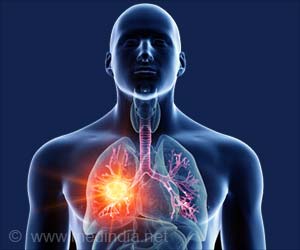Diesel fumes trigger respiratory reflexes which could potentially worsen underlying conditions, such as asthma.

‘Polycyclic aromatic hydrocarbons (PAHs) - tiny particles from diesel fumes directly stimulate nerves in the lungs, causing a reflex response in the airways.’





Previous research has shown a strong association between urban air pollution and respiratory symptoms such as coughing, wheezing and shortness of breath, but the underlying mechanism has been unclear. In the latest study, published in the Journal of Allergy and Clinical Immunology, an international team has shown that by-products from burning diesel fuel - called polycyclic aromatic hydrocarbons (PAHs) - directly stimulate nerves in the lungs, causing a reflex response in the airways.
The findings may provide a key link between exposure to air pollution on city streets and respiratory symptoms which can lead to hospitalisation for people at higher risk, such as the very young, the elderly, and those with respiratory diseases.
"In major European cities like London, we are already exceeding the recommended levels for air pollution, and these findings provide another reason why we need to curb these levels," said Professor Maria Belvisi, head of the Respiratory Pharmacology group at Imperial's National Heart and Lung Institute, who led the research.
"Pollution will affect everyone, but it affects people with underlying conditions, such as asthma, even more."
Advertisement
Previously, scientists showed that the effects of air pollution on the lungs of asthmatics correlated with the concentration of small, ultrafine particles inhaled, although the exact mechanism was unclear.
Advertisement
When the particles in diesel exhaust were processed to separate the insoluble carbon core from the soluble, outer organic fraction, the researchers found that it was chemicals on their surface (the PAHs) which directly stimulated nerves, while the central carbon particles did not.
The researchers say that the small size of the particles helps the chemicals to reach deep into the lungs, and cross membranes, where they can activate the nerves.
Professor Terry Tetley, co-lead author and also from Imperial's National Heart and Lung Institute, said: "This study, which brought together a multidisciplinary team of scientists, helps to address the previously unknown effects of particulate air pollution on respiratory symptoms. The findings further highlight the potential health impacts of urban air pollution on the public, particularly on those with underlying health conditions."
Polycyclic aromatic hydrocarbons (PAHs)
Working with researchers from King's College London and University of British Columbia, Professor Belvisi's team used commercially available diesel exhaust and generator diesel which mimics 'real-world' urban environment conditions to test the effects of exposure in a guinea pig model and animal nerve tissue. The effects were also tested on human tissue, using sections of vagus nerve from donor lung tissue that was surplus to transplant requirement.
The researchers found that when the tissue had been exposed to PAH's, sensory nerves responsible for the reflex events and initiating common respiratory symptoms, such as coughing and wheezing, were stimulated.
The evidence suggests that when these organic compounds are inhaled, they interact with receptors in the airways to cause oxidative stress. This stress then cascades and opens ion channels, tipping the electrochemical balance and causing the nerves to 'fire'.
These findings were further supported using nerve tissue from mice lacking the functioning ion channel (called TRPA1), in which this change to the electrochemical balance in the nerves, and subsequent symptoms, was not seen.
"Our work shows that particles from diesel exhaust can activate these ion channels, stimulating the nerves in the lungs. This may be responsible for the respiratory symptoms we see following exposure to urban air pollution," explained Professor Belvisi.
Professor Belvisi explained the latest work adds to a growing body of evidence demonstrating the direct effects of air pollution on public health. Combined with previous clinical exposure studies, in which people were exposed to real world levels of diesel exhaust particles in the lab, the mechanism illustrates the effects of typical exposure for people living and working in an urban environment.
"A significant number of hospital admissions are for people suffering with exacerbations of respiratory disease. If we can prevent these exacerbations which are as a consequence of the increase in symptoms, we're going to have fewer people needing hospital treatment”, said Professor Belvisi.
Dr Chris Carlsten, from the University of British Columbia and a co-author on the study, said: "Linking traffic-related pollution to cough broadens the scope of those affected by this ongoing public health challenge, and this can engage citizens to voice concern so that government responds with appropriate action. This is a great example of top-notch air pollution science once again motivating real-world action."
Dr Ian Mudway, from the Environmental Research Group at King's College London, added: "This study further highlights the adverse impacts diesel exhaust emissions can have on sensitive individuals and strengthens the scientific evidence base supporting moves to improve air quality in the UK."
Source-Eurekalert














